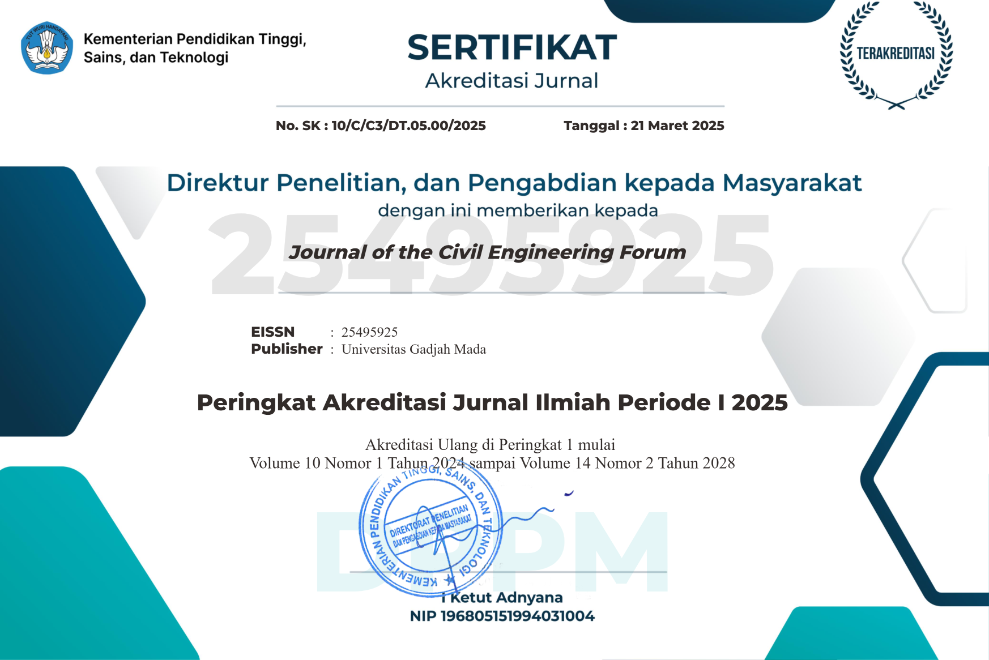The Use of Drop-Structures to Increase the Dissolved Oxygen Level along the Cibarani Channel
Abstract
The Cikapundung river basin community uses the Cibarani channel as a drainage system and water source for fishing. However, the test result released on 9th November 2020 revealed that the channel’s water quality failed to reach the class II raw water standards due to various domestic waste discharges. This led to the performance of various studies to identify pollution control techniques by limiting the wastewater discharge and quality, controlling the intake discharge, and using baffles. The Cibarani channel has a drop-structure that can improve the water quality, though the effect has not been previously detailed. Therefore, this study was intended to comprehensively examine the effect of the drop-structure along the Cibarani channel to improve water quality conditions, specifically the Dissolved Oxygen (DO) parameter. This study employed the one-dimensional HEC-RAS software to simulate the hydrodynamic and water quality conditions along the Cibarani channel, and the drop-structure was modelled using two alternatives consisting of a vertical wall and a steep riverbed. Subsequently, the drop-structure fitted with a vertical wall gave a more plausible reaeration rate of 125 day-1 and Root Mean Square Error (RMSE) value of 0.50. The placement of a similar configuration before the first housing of the channel increased the DO concentrations by an average of 4.37 mg/L. This was followed by the modelling of another drop-structure after the first housing to increase the DO levels at the downstream part. Eventually, the combination of the two new drop-structures succeeded in increasing the DO concentrations along the Cibarani channel to 3.3 - 6.9 mg/L.
References
Arief, A., 2014. Pengaruh Keberadaan Bendung dan Terjunan pada Konsentrasi Oksigen dalam Air. Jurnal Rekayasa Sipil, 2(2), pp. 154-166.
Bachrein, S., 2012. Pengembangan Daerah Aliran Sungai Cikapundung: Diagnostik Wilayah. Jurnal Bina Praja: Journal of Home Affairs Governance, 4(4), pp. 227-236.
Brunner, G. W. & CEIWR-HEC., 2010. HEC-RAS River Analysis System User’s Manual. Davis, CA: Hydrologic Engineering Center.
Damarany, P., Fachrul, M. F. & Astono, W., 2009. Kajian Kualitas Air Sungai Cipinang Bagian Hilir Ditinjau dari Parameter BOD dan DO menggunakan Model Qual2E. Jurnal Teknologi Lingkungan, 5(2), pp. 62-74.
Government of Indonesia., 2001. Peraturan Pemerintah Republik Indonesia Nomor 82 Tahun 2001 tentang Pengelolaan Kualitas Air dan Pengendalian Pencemaran Air.
Hayhera, F. O. & Yudianto, D., 2019. Studi Pengaruh Perubahan Kecepatan Aliran Air terhadap Peningkatan Kualitas Air pada Saluran irigasi Cibarani. Bandung, Seminar Nasional Teknik Sumber Daya Air.
Jha, R., Ojha, C. S. P. & Bhatia, K. K. S., 2001. Refinement of Predictive Reaeration Equations for a Typical Indian River. Hydrological Process, 15, pp. 1047-1060.
Ji, Z. G., 2008. Hydrodynamics and water quality. Modeling River, Lakes, and Estuaries. Hoboken, NJ: Wiley-Interscience.
Kashefipour, S. M. & Falconer, R. A., 2002. Longitudinal Dispersion Coefficient in Natural Channels. Water Research, 36(6), pp. 1596-1608.
Peavy, H. S., Rowe, D. R. & Tchobanoglous, G., 1985. Environmental Engineering. New York: McGraw-Hill.
Rahayu, Y., Juwana, I. & Marganingrum, D., 2018. Kajian Perhitungan Beban Pencemaran Air Sungai di Daerah Aliran Sungai (DAS) Cikapundung dari Sektor Domestik. Jurnal Rekayasa Hijau, 2(1), pp. 61-71.
Triane, D. & Suharyanto., 2015. Pemodelan Kualitas Air menggunakan Model QUAL2K (Studi Kasus: DAS Ciliwung). Jurnal Teknik Lingkungan, 21(2), pp. 190-200.
Trisnojoyo, R. R., Yudianto, D. & Wijaya, O. T., 2017. Studi Estimasi Beban Limbah Cair pada Saluran Irigasi menggunakan HEC-RAS. Bandung, Seminar Nasional Teknik Sumber Daya Air.
Ughbebor, J. N., Agunwamba, J. C. & Amah, V. E., 2012. Determination of Reaeration Coefficient K2 for Polluted Stream as a Function of Depth, Hydraulic Radius, Temperature and Velocity. Nigerian Journal of Technology, 31(2), pp. 174-180.
Yudianto, D. & Xie, Y., 2008. The Development of Simple Dissolved Oxygen Sag Curve in Lowland Non-Tidal River by using Matlab. Journal of Applied sciences in Environmental Sanitation, 3(3), pp. 137-
Copyright (c) 2021 The Author(s)

This work is licensed under a Creative Commons Attribution-ShareAlike 4.0 International License.
Copyright is granted to authors for the purpose of providing protection for articles written to describe experiments and their results. JCEF will protect and defend the work and reputation of the author and are also willing to address any allegations of violation, plagiarism, fraud, etc. against articles written and published by JCEF. JCEF is published under the terms of the Creative Commons Attribution-ShareAlike 4.0 International License (CC BY-SA 4.0). The author holds the copyright and assigns the journal rights to the first publication (online and print) of the work simultaneously.







